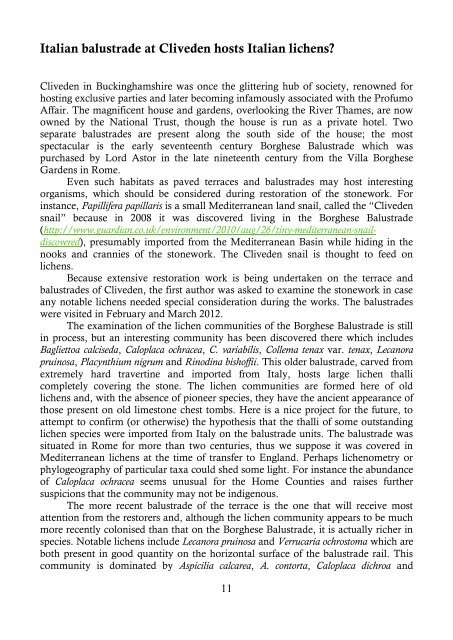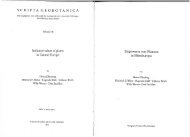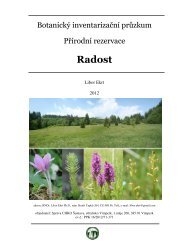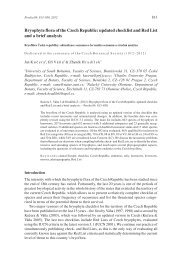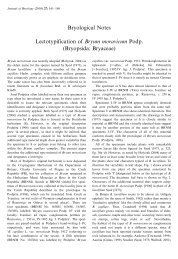Italian balustrade at Cliveden hosts Italian lichens?
Italian balustrade at Cliveden hosts Italian lichens?
Italian balustrade at Cliveden hosts Italian lichens?
Create successful ePaper yourself
Turn your PDF publications into a flip-book with our unique Google optimized e-Paper software.
<strong>Italian</strong> <strong>balustrade</strong> <strong>at</strong> <strong>Cliveden</strong> <strong>hosts</strong> <strong>Italian</strong> <strong>lichens</strong>?<br />
<strong>Cliveden</strong> in Buckinghamshire was once the glittering hub of society, renowned for<br />
hosting exclusive parties and l<strong>at</strong>er becoming infamously associ<strong>at</strong>ed with the Profumo<br />
Affair. The magnificent house and gardens, overlooking the River Thames, are now<br />
owned by the N<strong>at</strong>ional Trust, though the house is run as a priv<strong>at</strong>e hotel. Two<br />
separ<strong>at</strong>e <strong>balustrade</strong>s are present along the south side of the house; the most<br />
spectacular is the early seventeenth century Borghese Balustrade which was<br />
purchased by Lord Astor in the l<strong>at</strong>e nineteenth century from the Villa Borghese<br />
Gardens in Rome.<br />
Even such habit<strong>at</strong>s as paved terraces and <strong>balustrade</strong>s may host interesting<br />
organisms, which should be considered during restor<strong>at</strong>ion of the stonework. For<br />
instance, Papillifera papillaris is a small Mediterranean land snail, called the “<strong>Cliveden</strong><br />
snail” because in 2008 it was discovered living in the Borghese Balustrade<br />
(http://www.guardian.co.uk/environment/2010/aug/26/tiny-mediterranean-snaildiscovered),<br />
presumably imported from the Mediterranean Basin while hiding in the<br />
nooks and crannies of the stonework. The <strong>Cliveden</strong> snail is thought to feed on<br />
<strong>lichens</strong>.<br />
Because extensive restor<strong>at</strong>ion work is being undertaken on the terrace and<br />
<strong>balustrade</strong>s of <strong>Cliveden</strong>, the first author was asked to examine the stonework in case<br />
any notable <strong>lichens</strong> needed special consider<strong>at</strong>ion during the works. The <strong>balustrade</strong>s<br />
were visited in February and March 2012.<br />
The examin<strong>at</strong>ion of the lichen communities of the Borghese Balustrade is still<br />
in process, but an interesting community has been discovered there which includes<br />
Bagliettoa calciseda, Caloplaca ochracea, C. variabilis, Collema tenax var. tenax, Lecanora<br />
pruinosa, Placynthium nigrum and Rinodina bishoffii. This older <strong>balustrade</strong>, carved from<br />
extremely hard travertine and imported from Italy, <strong>hosts</strong> large lichen thalli<br />
completely covering the stone. The lichen communities are formed here of old<br />
<strong>lichens</strong> and, with the absence of pioneer species, they have the ancient appearance of<br />
those present on old limestone chest tombs. Here is a nice project for the future, to<br />
<strong>at</strong>tempt to confirm (or otherwise) the hypothesis th<strong>at</strong> the thalli of some outstanding<br />
lichen species were imported from Italy on the <strong>balustrade</strong> units. The <strong>balustrade</strong> was<br />
situ<strong>at</strong>ed in Rome for more than two centuries, thus we suppose it was covered in<br />
Mediterranean <strong>lichens</strong> <strong>at</strong> the time of transfer to England. Perhaps lichenometry or<br />
phylogeography of particular taxa could shed some light. For instance the abundance<br />
of Caloplaca ochracea seems unusual for the Home Counties and raises further<br />
suspicions th<strong>at</strong> the community may not be indigenous.<br />
The more recent <strong>balustrade</strong> of the terrace is the one th<strong>at</strong> will receive most<br />
<strong>at</strong>tention from the restorers and, although the lichen community appears to be much<br />
more recently colonised than th<strong>at</strong> on the Borghese Balustrade, it is actually richer in<br />
species. Notable <strong>lichens</strong> include Lecanora pruinosa and Verrucaria ochrostoma which are<br />
both present in good quantity on the horizontal surface of the <strong>balustrade</strong> rail. This<br />
community is domin<strong>at</strong>ed by Aspicilia calcarea, A. contorta, Caloplaca dichroa and<br />
11
Verrucaria nigrescens with other species such as Bagliettoa calciseda, Caloplaca variabilis,<br />
Solenopsora candicans, Toninia arom<strong>at</strong>ica and Verrucaria fuscella in smaller quantities.<br />
Caloplaca calcitrapa growing on the terrace <strong>balustrade</strong>, <strong>Cliveden</strong><br />
An unfamiliar specimen of Caloplaca with yellow bull<strong>at</strong>e areoles was collected<br />
(February 2012) from the newer <strong>balustrade</strong> and this was found to have thick-walled,<br />
“sand-clock” type spores. Arup (2006) st<strong>at</strong>es th<strong>at</strong> this type of spore is unique to<br />
Caloplaca dichroa in northern Europe, but these spores also occur in C. calcitrapa, a<br />
species restricted to the Mediterranean Basin (Navarro-Rosinés et al. 2000). The<br />
specimen from <strong>Cliveden</strong> fits well the description of C. calcitrapa but we were sceptical<br />
and wanted to confirm placement of the English lichen by molecular fingerprinting.<br />
Our first <strong>at</strong>tempt <strong>at</strong> genetic sequencing failed, perhaps due to the small amount of<br />
scraped m<strong>at</strong>erial or by strong contamin<strong>at</strong>ion with the glue Copydex. We suspected<br />
th<strong>at</strong> there may be further species of Caloplaca in Europe which have thick-walled<br />
spores and so we wavered with the identific<strong>at</strong>ion. A second, more richly fertile<br />
specimen was recently collected and this was confirmed as C. calcitrapa by reference<br />
to the ITS sequence (see below); unfortun<strong>at</strong>ely the specimen has been almost<br />
destroyed by removing parts for sequencing.<br />
We are left to specul<strong>at</strong>e whether C. calcitrapa, like the little snail, was imported<br />
to <strong>Cliveden</strong> from the Borghese Gardens in Rome or whether it is an overlooked<br />
member of our n<strong>at</strong>ive mycota. If it was imported, it appears to have disappeared<br />
12
from the Borghese Balustrade but spread to the terrace <strong>balustrade</strong> some fifty metres<br />
to the north where it occurs in three colonies.<br />
Bayesian phylogeny of the Caloplaca citrina group showing placement of the English<br />
specimen of Caloplaca from the <strong>Cliveden</strong> <strong>balustrade</strong>. Groups highlighted in grey are:<br />
(1) Caloplaca calcitrapa s. l<strong>at</strong>. containing also specimens without "sand-clock" spores<br />
and specimens without yellow areol<strong>at</strong>ed thallus (C. navasiana); (2) C. calcitrapa s. str.<br />
including the type of C. calcitrapa from the Mediterranean France and the specimen<br />
from England. For the methods of molecular analysis ask the authors.<br />
13
References<br />
Arup, U. (2006). A new taxonomy of the Caloplaca citrina group in the Nordic<br />
countries, except Iceland. Lichenologist 38: 1-120.<br />
Navarro-Rosinés, P., Gaya, E. & Roux, C. (2000) Caloplaca calcitrapa sp. nov.<br />
(Teloschistaceae) un nuevo liquen saxícolo-calcícola mediterráneo. Bulletin de la<br />
Société linnéenne de Provence 51: 145–152.<br />
Mark Powell¹ and Jan Vondrák²<br />
¹markpowell222@btinternet.com<br />
²Institute of Botany, Academy of Sciences, Zámek 1, CZ-252 43 Průhonice, Czech Republic.<br />
Email: j.vondrak@seznam.cz<br />
BLS Summer Vac<strong>at</strong>ion Scholarship report – a New Zealand<br />
lichen study<br />
Introduction and background<br />
I spent the Southern Hemisphere summer 2008/09 with a voluntary lichenological<br />
internship <strong>at</strong> Landcare Research in Dunedin, New Zealand, supervised by David<br />
Galloway. During th<strong>at</strong> time, I made the observ<strong>at</strong>ion th<strong>at</strong> the usually sexually<br />
reproducing species Icmadophila splachnirima (formerly Knightiella splachnirima) can<br />
also form marginal soralia. Interestingly, almost all strongly soredi<strong>at</strong>e specimens<br />
lacked m<strong>at</strong>ure apothecia but were densely covered with apothecium initials, which<br />
were apparently arrested <strong>at</strong> an early developmental stage. In contrast, fertile<br />
specimens were mostly esoredi<strong>at</strong>e. Further study showed th<strong>at</strong> the sterile and<br />
soredi<strong>at</strong>e form prevail in r<strong>at</strong>her exposed and dry micro-habit<strong>at</strong>s, while the fertile and<br />
mainly esoredi<strong>at</strong>e form is dominant in sheltered and constantly moist sites, though<br />
both forms grow in very close sp<strong>at</strong>ial proximity, just a few meters or even less than 1<br />
m apart. A continuous range of intermedi<strong>at</strong>es was observed as well, including rare<br />
specimens with m<strong>at</strong>ure apothecia and pronounced marginal soralia. I therefore<br />
conclude th<strong>at</strong> only one species exhibiting two reproductive modes is involved, and<br />
not a species-pair. Because the two reproductive modes are apparently rel<strong>at</strong>ed to<br />
contrasting micro-clim<strong>at</strong>ic conditions, I hypothesize, th<strong>at</strong> the switch from sexual to<br />
veget<strong>at</strong>ive reproduction might be a stress response to adverse growth conditions.<br />
David advised me to publish this observ<strong>at</strong>ion, so I prepared a short public<strong>at</strong>ion<br />
(Ludwig 2011) while finishing my biology degree in Germany. He also applied<br />
successfully for the BLS Summer Vac<strong>at</strong>ion Scholarship on my behalf, to give me the<br />
opportunity to continue my studies on I. splachnirima in NZ. This award allowed me<br />
to travel back to Dunedin after my gradu<strong>at</strong>ion in November 2010. A comprehensive<br />
and illustr<strong>at</strong>ed report of my work in NZ was submitted to the BLS Council last May,<br />
and this is a condensed form for the BLS Bulletin.<br />
14


